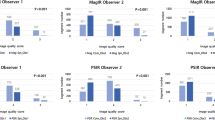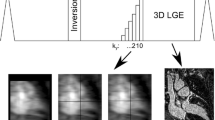Abstract
Objective
To qualitatively and quantitatively compare different late gadolinium enhancement (LGE) sequences acquired at 3T with a parallel RF transmission technique.
Methods
One hundred and sixty participants prospectively enrolled underwent a 3T cardiac MRI with 3 different LGE sequences: 3D Phase-Sensitive Inversion-Recovery (3D-PSIR) acquired 5 minutes after injection, 3D Inversion-Recovery (3D-IR) at 9 minutes and 3D-PSIR at 13 minutes. All LGE-positive patients were qualitatively evaluated both independently and blindly by two radiologists using a 4-level scale, and quantitatively assessed with measurement of contrast-to-noise ratio and LGE maximal surface. Statistical analyses were calculated under a Bayesian paradigm using MCMC methods.
Results
Fifty patients (70 % men, 56yo ± 19) exhibited LGE (62 % were post-ischemic, 30 % related to cardiomyopathy and 8 % post-myocarditis). Early and late 3D-PSIR were superior to 3D-IR sequences (global quality, estimated coefficient IR > early-PSIR : -2.37 CI = [-3.46 ; -1.38], prob(coef > 0) = 0 % and late-PSIR > IR : 3.12 CI = [0.62 ; 4.41], prob(coef > 0) = 100 %), LGE surface estimated coefficient IR > early-PSIR: -0.09 CI = [-1.11; -0.74], prob(coef > 0) = 0 % and late-PSIR > IR : 0.96 CI = [0.77; 1.15], prob(coef > 0) = 100 %). Probabilities for late PSIR being superior to early PSIR concerning global quality and CNR were over 90 %, regardless of the aetiological subgroup.
Conclusions
In 3T cardiac MRI acquired with parallel RF transmission technique, 3D-PSIR is qualitatively and quantitatively superior to 3D-IR.
Key Points
• Late gadolinium enhancement is an essential part of a cardiac MRI examination
• PSIR and IR sequences are the two possible options for LGE imaging
• At 3T with parallel RF transmission, PSIR sequences are significantly better
• One LGE sequence is sufficient, allowing an optimization of the acquisition time




Similar content being viewed by others
Abbreviations
- CAD:
-
Coronary artery disease
- CMR:
-
Cardiac magnetic resonance
- CNR:
-
Contrast to noise ratio
- LGE:
-
Late Gadolinium enhancement
- RF:
-
Radiofrequency
- TI:
-
Inversion time
References
American College of Cardiology Foundation Task Force on Expert Consensus D, Hundley WG, Bluemke DA et al (2010) ACCF/ACR/AHA/NASCI/SCMR 2010 expert consensus document on cardiovascular magnetic resonance: a report of the American College of Cardiology Foundation Task Force on Expert Consensus Documents. J Am Coll Cardiol 55:2614–2662
Wu KC (2009) Variation on a theme: CMR as the "one-stop shop" for risk stratification after infarction? J Am Coll Cardiol Img 2:843–845
Pennell DJ, Sechtem UP, Higgins CB et al (2004) Clinical indications for cardiovascular magnetic resonance (CMR): consensus panel report. Eur Heart J 25:1940–1965
Rehwald WG, Wagner A, Sievers B, Kim RJ, Judd RM (2007) Cardiovascular MRI: its current and future use in clinical practice. Expert Rev Cardiovasc Ther 5:307–321
Flett AS, Hasleton J, Cook C et al (2011) Evaluation of techniques for the quantification of myocardial scar of differing etiology using cardiac magnetic resonance. J Am Coll Cardiol Img 4:150–156
Kim RJ, Wu E, Rafael A et al (2000) The use of contrast-enhanced magnetic resonance imaging to identify reversible myocardial dysfunction. N Engl J Med 343:1445–1453
Klem I, Heitner JF, Shah DJ et al (2006) Improved detection of coronary artery disease by stress perfusion cardiovascular magnetic resonance with the use of delayed enhancement infarction imaging. J Am Coll Cardiol 47:1630–1638
Laissy JP, Pasi N, Bazeli R, Schouman-Claeys E, Serfaty JM (2010) Delayed myocardial enhancement and diagnosis of acute coronary syndrome with normal coronarography. J Radiol 91:602–608
Silvera S, Palangie E, Marmursztejn J et al (2010) Which non-ischemic myocardial diseases show delayed enhancement, and what are their imaging characteristics. J Radiol 91:609–614
Weaver JC, McCrohon JA (2008) Contrast-enhanced cardiac MRI in myocardial infarction. Heart Lung Circ 17:290–298
Kramer CM, Barkhausen J, Flamm SD, Kim RJ, Nagel E, Society for Cardiovascular Magnetic Resonance Board of Trustees Task Force on Standardized P (2013) Standardized cardiovascular magnetic resonance (CMR) protocols 2013 update. J Cardiovasc Magn Reson Off J Soc Cardiovasc Magn Reson 15:91
Jacquier A, Bartoli B, Flavian A et al (2010) Delayed myocardial enhancement: optimizing the MR imaging protocol. J Radiol 91:598–601
Xu J, Kim D, Otazo R et al (2013) Towards a five-minute comprehensive cardiac MR examination using highly accelerated parallel imaging with a 32-element coil array: feasibility and initial comparative evaluation. J Magn Reson Imaging JMRI 38:180–188
Cheng AS, Selvanayagam JB (2010) High field cardiac magnetic resonance imaging--current and future perspectives. Heart Lung Circ 19:145–153
Gerretsen SC, Versluis B, Bekkers SC, Leiner T (2008) Cardiac cine MRI: comparison of 1.5 T, non-enhanced 3.0 T and blood pool enhanced 3.0 T imaging. Eur J Radiol 65:80–85
Gutberlet M, Noeske R, Schwinge K, Freyhardt P, Felix R, Niendorf T (2006) Comprehensive cardiac magnetic resonance imaging at 3.0 Tesla: feasibility and implications for clinical applications. Invest Radiol 41:154–167
Willinek WA, Schild HH (2008) Clinical advantages of 3.0 T MRI over 1.5 T. Eur J Radiol 65:2–14
Rajiah P, Bolen MA (2014) Cardiovascular MR imaging at 3 T: opportunities, challenges, and solutions. Radiographics 34:1612–1635
Wieben O, Francois C, Reeder SB (2008) Cardiac MRI of ischemic heart disease at 3 T: potential and challenges. Eur J Radiol 65:15–28
Cohen J (1960) A coefficient of agreement for nominal scales. Educ Psychol Meas 20:37–46
Ronald Christensen WJ, Branscum A, Hanson TE (2010) Bayesian ideas and data analysis: an introduction for scientists and statisticians. CRC Press
Freedman L (1996) Bayesian statistical methods. BMJ 313:569–570
Ntzoufras I (2009) Bayesian modelling using WinBUGS. Wiley, Hoboken
Lunn DJ, Thomas A, Best N, Spiegelhalter D (2000) WinBUGS - a Bayesian modelling framework: concepts, structure, and extensibility. Stat Comput 10:325–337
Chen X, Lu M, Yin G et al (2013) Three-dimensional phase-sensitive inversion-recovery Turbo FLASH sequence for the assessment of left ventricular myocardial scar in swine. PLoS One 8, e78305
Kino A, Keeling AN, Farrelly CT et al (2011) Assessment of left ventricular myocardial scar in infiltrative and non-ischemic cardiac diseases by free breathing three dimensional phase sensitive inversion recovery (PSIR) TurboFLASH. Int J Cardiovasc Imaging 27:527–537
Kino A, Zuehlsdorff S, Sheehan JJ et al (2009) Three-dimensional phase-sensitive inversion-recovery turbo FLASH sequence for the evaluation of left ventricular myocardial scar. AJR Am J Roentgenol 193:W381–W388
Jablonowski R, Nordlund D, Kanski M et al (2013) Infarct quantification using 3D inversion recovery and 2D phase sensitive inversion recovery; validation in patients and ex vivo. BMC Cardiovasc Disord 13:110
Elgeti T, Abdel-Aty H, Wagner M et al (2007) Assessment of late gadolinium enhancement in nonischemic cardiomyopathy: comparison of a fast Phase-Sensitive Inversion Recovery Sequence (PSIR) and a conventional segmented 2D gradient echo recall (GRE) sequence--preliminary findings. Invest Radiol 42:671–675
Huber A, Bauner K, Wintersperger BJ et al (2006) Phase-sensitive inversion recovery (PSIR) single-shot TrueFISP for assessment of myocardial infarction at 3 tesla. Invest Radiol 41:148–153
Kido T, Kido T, Nakamura M et al (2014) Three-dimensional phase-sensitive inversion recovery sequencing in the evaluation of left ventricular myocardial scars in ischemic and non-ischemic cardiomyopathy: comparison to three-dimensional inversion recovery sequencing. Eur J Radiol 83:2159–2166
Morita K, Utsunomiya D, Oda S et al (2013) Comparison of 3D phase-sensitive inversion-recovery and 2D inversion-recovery MRI at 3.0 T for the assessment of late gadolinium enhancement in patients with hypertrophic cardiomyopathy. Acad Radiol 20:752–757
Katscher U, Bornert P (2006) Parallel RF transmission in MRI. NMR Biomed 19:393–400
Willinek WA, Gieseke J, Kukuk GM et al (2010) Dual-source parallel radiofrequency excitation body MR imaging compared with standard MR imaging at 3.0 T: initial clinical experience. Radiology 256:966–975
Nelles M, Konig RS, Gieseke J et al (2010) Dual-source parallel RF transmission for clinical MR imaging of the spine at 3.0 T: intraindividual comparison with conventional single-source transmission. Radiology 257:743–753
Krishnamurthy R, Pednekar A, Kouwenhoven M, Cheong B, Muthupillai R (2013) Evaluation of a subject specific dual-transmit approach for improving B1 field homogeneity in cardiovascular magnetic resonance at 3T. J Cardiovasc Magn Reson Off J Soc Cardiovasc Magn Reson 15:68
Mueller A, Kouwenhoven M, Naehle CP et al (2012) Dual-source radiofrequency transmission with patient-adaptive local radiofrequency shimming for 3.0-T cardiac MR imaging: initial experience. Radiology 263:77–85
Strach K, Clauberg R, Muller A et al (2013) Feasibility of high-dose dobutamine stress SSFP Cine MRI at 3 Tesla with patient adaptive local RF Shimming using dual-source RF transmission: initial results. Röfo 185:34–39
Jia H, Wang C, Wang G et al (2013) Impact of 3.0 T Cardiac MR Imaging Using Dual-Source Parallel Radiofrequency Transmission with Patient-Adaptive B1 Shimming. PLoS One 8, e66946
Kellman P, Arai AE, McVeigh ER, Aletras AH (2002) Phase-sensitive inversion recovery for detecting myocardial infarction using gadolinium-delayed hyperenhancement. Magn Reson Med 47:372–383
Kim RJ, Shah DJ, Judd RM (2003) How we perform delayed enhancement imaging. J Cardiovasc Magn Reson Off J Soc Cardiovasc Magn Reson 5:505–514
Doltra A, Skorin A, Hamdan A et al (2014) Comparison of acquisition time and dose for late gadolinium enhancement imaging at 3.0 T in patients with chronic myocardial infarction using Gd-BOPTA. Eur Radiol 24:2192–2200
Laissy JP, Hyafil F, Feldman LJ et al (2005) Differentiating acute myocardial infarction from myocarditis: diagnostic value of early- and delayed-perfusion cardiac MR imaging. Radiology 237:75–82
Kellman P, Arai AE (2012) Cardiac imaging techniques for physicians: late enhancement. J Magn Reson Imaging JMRI 36:529–542
Acknowledgments
The scientific guarantor of this publication is Pr. Catherine Roy. The authors of this manuscript declare no relationships with any companies, whose products or services may be related to the subject matter of the article. The authors state that this work has not received any funding. One of the authors is a biostatistician: Dr. Mickaël Schaeffer. Institutional Review Board approval was obtained. Written informed consent was obtained from all subjects (patients) in this study. No study subjects or cohorts have been previously reported. Methodology: prospective, observational, performed at one institution.
Conflicts of interest
None
Author information
Authors and Affiliations
Corresponding author
Rights and permissions
About this article
Cite this article
Schultz, A., Caspar, T., Schaeffer, M. et al. Late gadolinium enhancement cardiac imaging on a 3T scanner with parallel RF transmission technique: prospective comparison of 3D-PSIR and 3D-IR. Eur Radiol 26, 1547–1555 (2016). https://doi.org/10.1007/s00330-015-4002-y
Received:
Revised:
Accepted:
Published:
Issue Date:
DOI: https://doi.org/10.1007/s00330-015-4002-y




